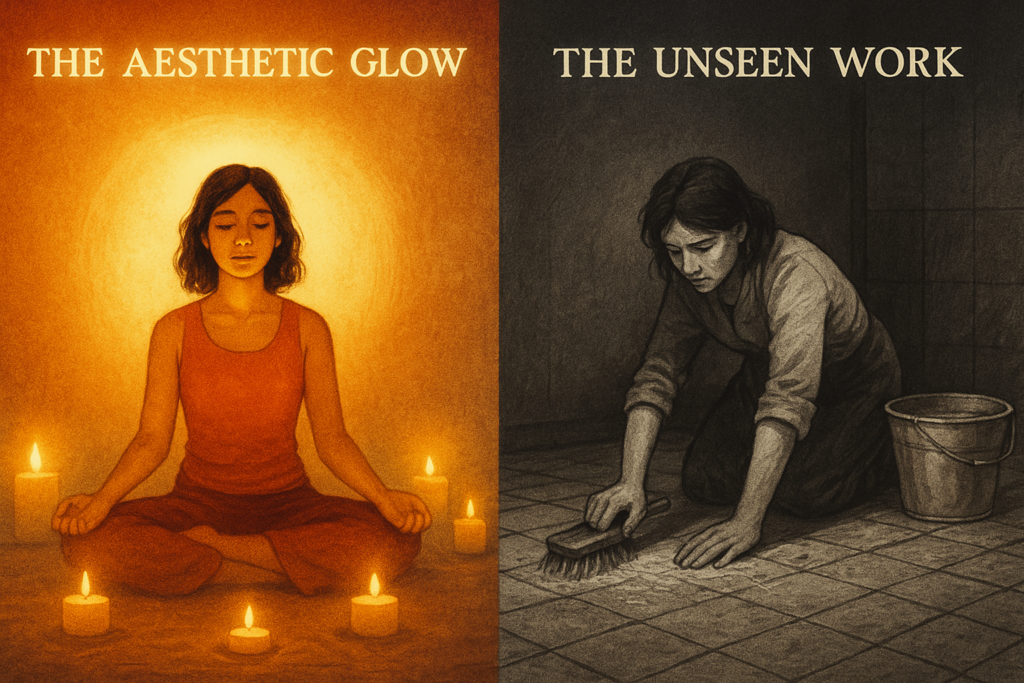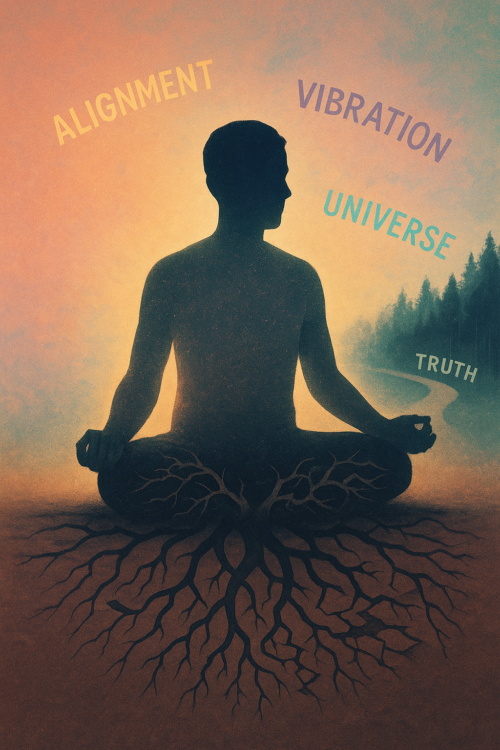The Glow Without Gravity
They come back from the jungle glowing.
Three, four ceremonies deep, breath airy, eyes soft, voice slower now – like something important has been reconfigured. You can feel the shift they’re trying to project, like a frequency humming around the edges of their posture.
They talk about what they saw. What they released. What they remembered. And for a moment, you want to believe it too – want to believe that healing really does happen like lightning, that the past can be undone in a single vision, that a sense of peace means the work is done.
But a few days later, they start ghosting people who knew them before. They pull away from the messy conversations. They dodge the apology they owe. They reframe their exit as “alignment.” They talk about vibration instead of impact. They disappear with softness – but disappear all the same.
And you realize: they didn’t transform. They transcended. Not the same thing.
The Addiction to Insight
Modern spirituality isn’t failing because it’s too mystical. It’s failing because it’s allergic to consequence. We want transcendence without disruption. Insight without cost. A changed life without a changed self. We are sold “awakening” that doesn’t demand anything of us except a credit card and curated vulnerability. But the actual spiritual path? It’s mundane. Repetitive. Ethical. Often lonely. Frequently inconvenient. And always disruptive to the version of ourselves we’d rather preserve.
We confuse catharsis with character. Emotion with evolution. The moment something moves us, we assume we’ve moved. But emotion is cheap. Insight is easy. What’s rare is integration. What’s rare is following through when no one’s watching.
We say we want the truth – but we want it fast. And we want it soft. That’s why so many facilitators, coaches, guides, and healers now ask: “What’s your truth?” – as if truth is a pick-your-own-adventure feeling, conjured on cue.
But most of what we call “truth” in those moments is just what feels emotionally congruent in the moment. It’s not truth. It’s mood.
Real truth isn’t whatever you say with a straight spine and a trembling voice. Real truth is what remains true the next morning – what costs you something when you say it out loud.
Truth isn’t an aesthetic. It’s a commitment. It’s the unflinching return to the thing you know is real – after it stops making you feel special, after it stops serving your story.
And that’s what we run from. Because real transformation isn’t content. It’s consequence. It means enduring discomfort long after the revelation fades. It means closing the tab, stepping away from the mirror, and turning toward the person you’ve been avoiding. It’s quiet, gritty, and most of all: unshareable.

What Real Change Actually Feels Like
Real transformation isn’t radiant.
It doesn’t make you prettier, or clearer, or easier to be around right away. It doesn’t clean your aura or improve your brand. It destabilizes you. It interrupts. It leaves behind something raw that doesn’t resolve on schedule. You begin to notice the lies your life was built around – and then, if you’re brave, you start telling the truth that could cost you everything.
That’s the part missing in most of what we now call “healing.” Not the insight. Not the access to inner states. The cost.
Because real healing doesn’t just open you up. It asks you to close certain doors behind you. For good.
It means becoming unrecognizable to the self you carefully curated to survive.
It means your calendar changes. Your friendships shift. Your default tone in conversation softens or sharpens depending on what you used to weaponize. It means you forfeit performative depth in favor of inconvenient honesty.
It looks like a friend asking if you’re okay, and instead of saying “I’m processing,” you admit, “No. I’m being called to change. And I don’t like what it’s asking of me.”
The Lie of the Lightning Strike
The lie is that healing is a moment. A strike. A psychedelic breakthrough. A vision of your grandmother that makes you sob.
But those moments are just the beginning – an invitation, not a transformation.
Real change is what you do the next morning. And the one after that. And the one after that. It’s found in who you circle back to. Who you apologize to. Who you stop avoiding.
We’re not addicted to healing. We’re addicted to the emotional high of beginning it—without finishing anything.
Even in seemingly harmless settings, the pattern repeats. We roll out a yoga mat, sit cross-legged, and are asked to “set an intention.”
But how can you set an intention you haven’t earned? How can you define a spiritual aim in the time it takes to unclip a water bottle? These micro-performances of presence ask for no sacrifice. They promise transcendence in 45 minutes flat—and then we leave, unchanged, but congratulated for attending.
The form mimics depth. But there is no ground underneath.
We keep finding newer ways to simulate transformation without being touched by it. We keep returning to the sensation of meaning, not the practice of it. And we keep walking out feeling lighter, but still carrying everything.

The Fear We Don’t Name
Why do we run from integration?
Because integration means consequence. It means breaking up with people who still want the old version of you. It means being accountable in ways that aren’t flattering. It means letting go of the very tools you used to survive.
We don’t fear failure. We fear the cost of success.
Success means change. And change means rupture.
We’d rather loop in the familiar chaos than be exiled by our own growth.
We’d rather glow briefly than dim long enough to become someone solid.
We’d rather stay on fire than walk through the ash.
And deep down, we know: the moment we actually change, there’s no going back. No social reward. Just a longer, quieter road.
How the Culture Enables It
Every industry around healing profits when you stay on the treadmill.
There’s always another retreat. Another workshop. Another breathwork journey. Another plant. Another map of your inner child to unearth.
And now there are entire towns built around the glow. You feel it in the air in places like Tulum and Ubud – words like alignment, vibration, flow, the universe tossed around like petals. Everything smells like meaning, but nothing holds weight. The language is everywhere, but the consequences are nowhere. Truth has become a tone. Depth has become a vibe.
These places aren’t inherently hollow. But they’ve become symbols of how easily the sacred gets repackaged as atmosphere. How spirituality becomes something you visit, not something you live. Healing becomes a playlist. Presence becomes posture. Everything feels deep, but no one is changed.
Because real accountability is unphotogenic. It’s slow. It’s often invisible. It shows up in tone, in timing, in how long you’re willing to sit in someone else’s discomfort without correcting the story to make yourself look better.
It doesn’t sell. It doesn’t glow. But it’s the only thing that ever made someone trustworthy.
And so the culture keeps us in orbit – circling insight without ever landing in consequence.
We remain emotionally stimulated but ethically weightless.
INTERLUDE: A Brief Pause
This isn’t a takedown of spirituality. It’s a reckoning with the parts of us that would rather feel deep than become different. It’s a call to rebuild practice that survives the ceremony. Language that lives past the post.
It’s about letting insight become architecture. Letting healing become relationship. Letting truth become weight-bearing.

VII. The Quiet Work
What does real spirituality look like?
Not the light show. Not the download. Not the ceremony.
It looks like:
- Not sending the clever text
- Calling your mom back
- Owning the thing you hoped they never bring up
- Choosing less stimulation so you can stay present longer
- Waking up and doing the hard thing again, with no witness, no praise, no post
The sacred isn’t always luminous. Often, it’s heavy. It’s boring. It’s a rhythm you return to even when you don’t feel like it.
It’s a life that makes fewer excuses.
And it’s not chosen once. It’s chosen in the moments when old habits could come back with ease and disguise themselves as insight.
It’s chosen again when the glow fades.
It’s what you reach for in the dark.
To Be Transformed
To be transformed is not to glow. It is to grow in ways that make you less recognizable to the parts of yourself that were built on defense, performance, and fear.
It is to live differently even when it’s inconvenient. To tell the truth when silence would be easier. To choose humility over style. To change not just what you say, but how you act when no one is looking.
You can cry in the jungle. You can journal for hours. You can speak with your whole chest about your ancestors, your downloads, your rebirth. But if you come back and nothing’s different?
You were moved. Not changed.
And that’s the line most people will never cross.
